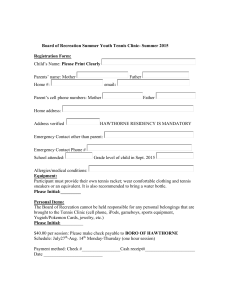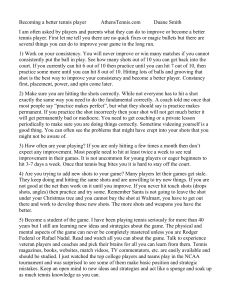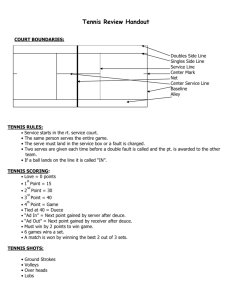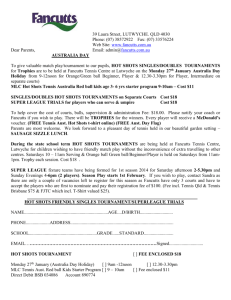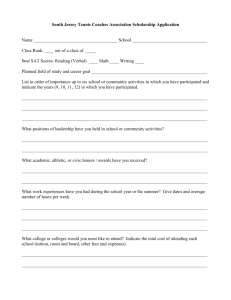Its In The Legs The modern professional game has been defined by
advertisement
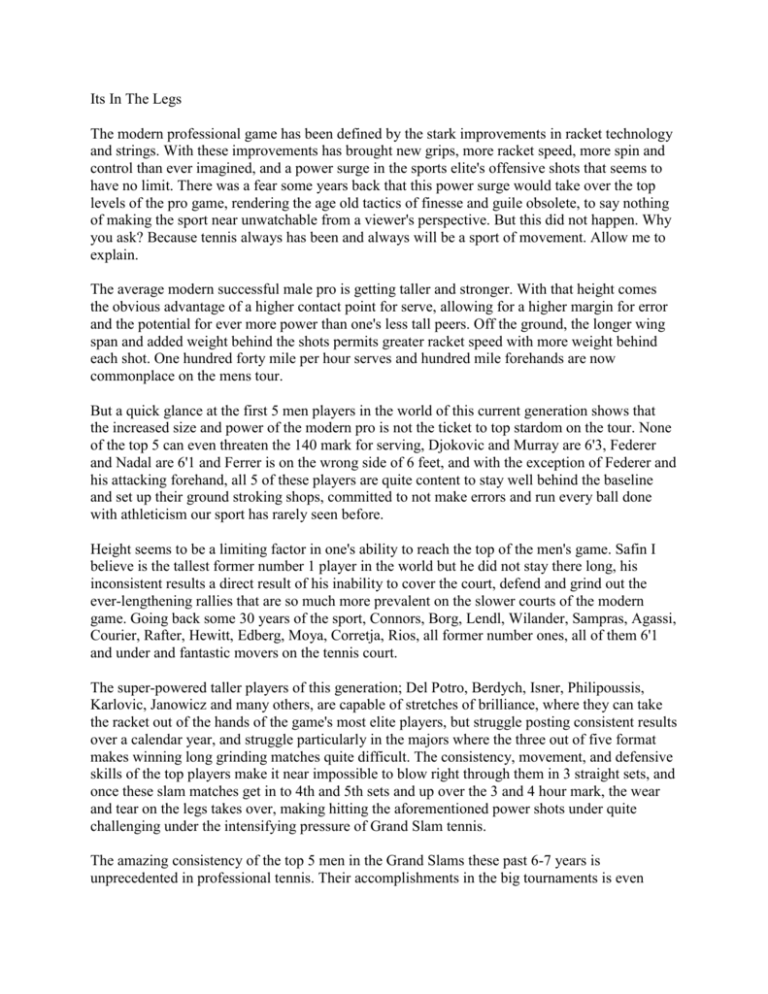
Its In The Legs The modern professional game has been defined by the stark improvements in racket technology and strings. With these improvements has brought new grips, more racket speed, more spin and control than ever imagined, and a power surge in the sports elite's offensive shots that seems to have no limit. There was a fear some years back that this power surge would take over the top levels of the pro game, rendering the age old tactics of finesse and guile obsolete, to say nothing of making the sport near unwatchable from a viewer's perspective. But this did not happen. Why you ask? Because tennis always has been and always will be a sport of movement. Allow me to explain. The average modern successful male pro is getting taller and stronger. With that height comes the obvious advantage of a higher contact point for serve, allowing for a higher margin for error and the potential for ever more power than one's less tall peers. Off the ground, the longer wing span and added weight behind the shots permits greater racket speed with more weight behind each shot. One hundred forty mile per hour serves and hundred mile forehands are now commonplace on the mens tour. But a quick glance at the first 5 men players in the world of this current generation shows that the increased size and power of the modern pro is not the ticket to top stardom on the tour. None of the top 5 can even threaten the 140 mark for serving, Djokovic and Murray are 6'3, Federer and Nadal are 6'1 and Ferrer is on the wrong side of 6 feet, and with the exception of Federer and his attacking forehand, all 5 of these players are quite content to stay well behind the baseline and set up their ground stroking shops, committed to not make errors and run every ball done with athleticism our sport has rarely seen before. Height seems to be a limiting factor in one's ability to reach the top of the men's game. Safin I believe is the tallest former number 1 player in the world but he did not stay there long, his inconsistent results a direct result of his inability to cover the court, defend and grind out the ever-lengthening rallies that are so much more prevalent on the slower courts of the modern game. Going back some 30 years of the sport, Connors, Borg, Lendl, Wilander, Sampras, Agassi, Courier, Rafter, Hewitt, Edberg, Moya, Corretja, Rios, all former number ones, all of them 6'1 and under and fantastic movers on the tennis court. The super-powered taller players of this generation; Del Potro, Berdych, Isner, Philipoussis, Karlovic, Janowicz and many others, are capable of stretches of brilliance, where they can take the racket out of the hands of the game's most elite players, but struggle posting consistent results over a calendar year, and struggle particularly in the majors where the three out of five format makes winning long grinding matches quite difficult. The consistency, movement, and defensive skills of the top players make it near impossible to blow right through them in 3 straight sets, and once these slam matches get in to 4th and 5th sets and up over the 3 and 4 hour mark, the wear and tear on the legs takes over, making hitting the aforementioned power shots under quite challenging under the intensifying pressure of Grand Slam tennis. The amazing consistency of the top 5 men in the Grand Slams these past 6-7 years is unprecedented in professional tennis. Their accomplishments in the big tournaments is even more remarkable with the fact that every player trying to break through their ranks are highly skilled players, often with more than one major weapon in their shot arsenals. But shots come and go in a match or over a year. What truly separates the top 5 from the rest is their movement; their ability to defend the court like few ever before them. And not just get the ball back; they routinely are able to get their feet planted well outside the doubles alleys to create power and accuracy from places on the court where the less mobile are fortunate to just get a racket on the ball. Such abilities to create offense from near dead court positions makes coming forward to close out points against them a precarious proposition at best. Hence why the modern pro game being battled out from behind the baseline, even on the traditionally fast grass courts of the All England Club, with those with the best wheels and balance consistently coming out ahead. So how does such information apply to us tennis mortals? I have yet to meet anyway who can coach quickness and speed, though a rigorous training and fitness regimen certainly wouldn't hurt any of us. Short of that, let's work with what we have today and focus on our current state of footwork and see if we can make some progress here. Picture one seems somewhat benign; the position is commonly referred to as ready position. But it is the foundation to all proper movement to whatever random shot that comes our way. We learn tennis from this position. The player is equally prepared to turn to the right or left to get their upper body in to hitting position. Two very important aspects of ready position are the knees are bent and the weight on the feet is off the heels and on the toes, but not just on the toes, but on the inside of the foot also. If your weight is strictly on your toes, you're prepared to jump up and down. The tennis player is going to make an explosive step either to the right, left, forward or backward. Putting the weight on the inside of the foot with a bent knee has the player in the most explosive position to accelerate to whatever shot comes their way. The most important aspect to moving to a tennis ball is to lead with your lower body. If you move your upper body first in the direction of the shot you are chasing, you will be off balance immediately; add a couple quick movements to that off balance start and this next shot is in trouble. The great movers in the game are able to keep their upper bodies and head very still during the whole movement process. With our knees bent, an explosive and lengthy first step is possible. Remember, you may only have time to take three steps to run down a hard hit ball. Three good strides can get you from the center of the court to the sideline in balance and in solid hitting position. If you start with a passive small step your feet will be unorganized and you will find yourself just running down and retrieving balls instead of being organized and balance enough to get to the wide ball and be able to drive it. Picture two is a common finishing position for a running wide forehand. All indications are the player made a pretty good swing. If you compare the ready position to the forehand finishing position, well, they couldn't be much further apart. Now we all are guilty at times of cracking a good one and wanting to strike the pose and admire it a bit, but the reality is, there's a tennis point going on, and you're still in it, and you're a long ways from the center of the court in your poised ready position, prepared equally to go right, left forward or backward for the next random shot to come your way. Which brings me to the most important part of all tennis court movement. The most important movements we do in a tennis rally are the movements we make between shots. We start shots from a balanced centered position with our weight back. When we run them down we are at the sideline, turned 90 degrees from our opponent with our weight now forward having just struck a shot. In order to repeat that movement time after time, we must recover to the center of the court, get out shoulders and feet square to our opponent, and get our weight back again so we can shift it again on the next shot. That's what we need to do immediately after striking whatever shot we hit. Remember, we learn tennis from the ready position. If you are poised and set when your opponent strikes the ball your way, you have an excellent chance of executing the strokes you've learned. Anything short of that and you will be running around and scrambling with little to no idea where your weight and feet are, creating off balance hitting positions when you go to strike the ball. Of course, you can't have an out of body experience and see yourself from afar. It's very hard to tell when you are a little out of position, though you will find out soon enough when you take an aggressive swing at the next ball and it goes far from your desired target. This recover after your shots method is never more relevant than after you finish your serve Picture three shows what we look like after finishing our service stroke. We just couldn't be less prepared to hit a groundstroke if we had to. It's no coincidence that the most often missed ball by a server is the first ball after the return. If one does not recover quickly from the finished serving position back in to the ground stroke ready position, the next shot will be a mess. Again, it's the movements we make after we hit a shot are the most important to being able to sustaining consistent competent tennis rallies. In summation, if this we're easy to do, we would all be world class tennis players. It's not. But I don't think it's a stretch to guess that recovery footwork and balance is the farthest thing from your mind in the middle of a heated rally. In the short term, to improve your game, you need it to be, with the hopes over time these movements become second nature to you the tennis player and your focus can go to more strategic thoughts as you do battle out there on the courts. The human mind was not devised with tennis in mind; it can only handle one thought at a time. Make your recovery movements that thought for a while, and I guess your game will improved markedly.
